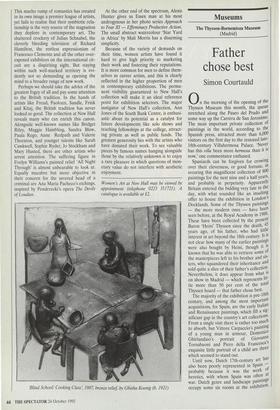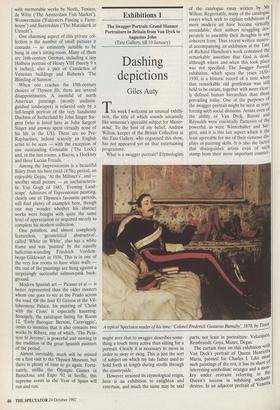Museums
The Thyssen-Bornemisza Museum (Madrid)
Father chose best
Simon Courtauld
On the morning of the opening of the Thyssen Museum this month, the queue stretched along the Paseo del Prado and some way up the Carrera de San Jeronimo. The most important private collection of paintings in the world, according to the Spanish press, attracted more than 6,000 visitors on the first day to the restored late- 18th-century Villahermosa Palace. 'Never has this villa been more hermosa than it is now,' one commentator enthused.
Spaniards can be forgiven for crowing over their cleverness, or good fortune, in securing this magnificent collection of 800 paintings for the next nine and a half years, and probably in perpetuity. ApparentlY Britain entered the bidding very late in the day, with what sounded like an insulting offer to house the exhibition in London's Docklands. Some of the Thyssen paintings — the more modern ones — have been seen before, at the Royal Academy in 1988. These have been collected by the present Baron `Heini' Thyssen since the death, 45 years ago, of his father, who had little interest in art beyond the 18th century. It is not clear how many of the earlier paintings were also bought by Heini, though it is known that he was able to retrieve some of the masterpieces left to his brother and sis- ters, who squandered their inheritance and sold quite a slice of their father's collection.. Nevertheless, it does appear from what on show in Madrid — which represents lit- tle more than 50 per cent of the total Thyssen hoard — that father chose best. The majority of the exhibition is pre-18th century, and among the most important acquisitions, for Spain, are the early Italian and Renaissance paintings, which fill a sig- nificant gap in the country's art collections. From a single visit there is rather too much to absorb, but Vittore Carpaccio's painting of a young man in armour, Domenico Ghirlandaio's portrait of Giovanir Tornabuoni and Piero della Francesca s exquisite little portrait of a child are three which seemed to stand out.
Until now, Dutch 17th-century art has also been poorly represented in Spain — probably because it was the work of heretics, with whom Spain was often at war. Dutch genre and landscape paintings occupy some six rooms at the exhibition, with memorable works by Neefs, Teniers, de Witte (The Amsterdam Fish Market'), Wouwermans ('Falconers Passing a Farm- house') and Saenredam (The Mariakerk in Utrecht').
One charming aspect of this private col- lection is the number of small pictures it contains — so eminently suitable to be hung in one's sitting-room. Many of them are 16th-century German, including a tiny Holbein portrait of Henry VIII (barely 9 x 6 inches), also a pair of Canalettos of Venetian buildings and Rubens's The Blinding of Samson'.
When one reaches the 19th-century choices of Thyssen fils, there are several disappointments. A roomful of north American paintings (mostly undistin- guished landscapes) is relieved only by a full-length portrait of the very handsome Duchess of Sutherland by John Singer Sar- gent (who is listed here as John Sargent Singer and anyway spent virtually none of his life in the US). There are no Pre- Raphaelites, indeed scarcely an English artist to be seen — with the exception of one outstanding Constable (The Lock') and, in the last rooms, a Bacon, a Hockney and three Lucian Freuds.
Among the Impressionists is a beautiful Sisley from his best (mid-1870s) period, an enjoyable Degas, 'At the Milliner's', and — another small picture — an uncharacteris- tic Van Gogh of 1885, 'Evening Land- scape'. Admirers of Expressionist painting, clearly one of Thyssen's favourite periods, will find plenty of examples here, though one may wonder whether his abstract works were bought with quite the same level of appreciation or acquired merely to complete his modern collection.
One pointless, and almost completely featureless, 'geometrical abstraction', called 'White on White', also has a white frame and was 'painted' by the equally ludicrous-sounding Friedrich Vordem- berge-Gildewart in 1936. This is in one of the very few rooms to have white walls — the rest of the paintings are hung against a surprisingly successful salmon-pink back- ground.
Modern Spanish art — Picasso et al — is better represented than the older masters whom one goes to see at the Prado across the road. Of the four El Grecos at the Vil- lahermosa Palace, his painting of 'Christ with the Cross' is especially haunting. Strangely, the catalogue listing for Room 12, 'Early Baroque: Bernini, Caravaggio', omits to mention that it also contains two works by Ribera, one of which, The Peni- tent St Jerome', is powerful and moving in the tradition of the great Spanish painters of the period.
Almost inevitably, much will be missed on a first visit to the Thyssen Museum, but there is plenty of time to go again. Fortu- nately, unlike the Olympic Games in Barcelona and Expo '92 in Seville, this supreme event in the Year of Spain will run and run.



































































 Previous page
Previous page